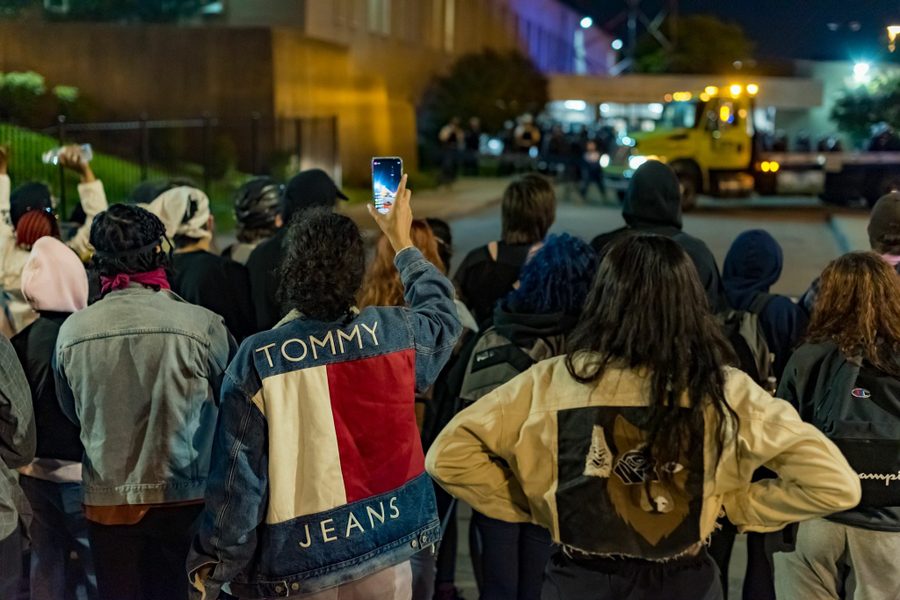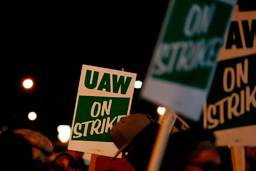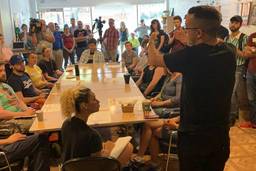They Came to Support People Getting Out of Jail. Then They Were Attacked By Police.
Jail support outfits have not been spared police backlash.
Elizabeth King

Only a few days had passed since the police killed him, but people around the country were already filling the streets to protest for George Floyd, a 46-year-old Black from Minnesota.
From California to Chicago to New York, demonstrators rebelled against the fatal trifecta of policing, racism and capitalism, marching and chanting, emptying the shelves of corporate stores, fighting with police, and in Minneapolis, setting flame to the Third Precinct.
As quickly as law enforcement agencies moved to quash the demonstrations, jail support crews were preparing to stand up for the people being dragged off to police wagons. Jail support crews — people who care for arrestee’s primary needs immediately after they are released — work against the tide of mass arrests. Jail supporters carry out a wide array of activities and procedures, including often holding vigils outside jailhouses.
These crews have had their work cut out for them lately: Police squads, many of them suited up in riot gear, stormed demonstrators in several cities, while the National Guard deployed in the streets. As police officers around the country attacked, injured and rounded up protesters, journalists and bystanders, more than 11,000 people found themselves facing charges by June 2, only a few days into the uprising, according to a BuzzFeed investigation. As of June 27, the crackdown had led to 116 federal felony cases and at least 188 lower-court felony cases, Michael Loadenthal of the Prosecution Project confirmed on Twitter.
Jail support outfits have not been spared the police backlash, with police officers arresting and verbally harassing some crews as they went about their work.
These crews typically collect and supply food, drinks, blankets, first aid supplies, cigarettes and rides home for arrestees once they’re released from jail. It’s also common for jail support crews to include a street medic who is trained in basic first aid to offer care to people getting out of jail. While doing jail support, supporters also call jails to try to obtain information about people being held, and pressure jails to release arrestees. Jail support crew members also typically offer arrestees information regarding pro bono legal services, and collect information so that movement lawyers can track their cases. The aim is to show solidarity with people who were arrested immediately upon their release in order to lessen the personal costs of militant resistance, ensure that nobody arrested for movement work slips through the cracks during the legal process, and to show love for people on the frontlines.
Jail support encompasses an array of activities and procedures that community organizers and activists utilize in the event of mass arrests. In many cases, jail support for mass arrestees includes a crew of on-the-ground organizers who hold vigil outside of jails where arrestees are held.
Though jail support and police harassment of jail supporters is not new, nash Sheard, co-founder of the Black Movement-Law Project, tells In These Times, “Are we seeing more and more aggressive and more visible repression of these groups? Yeah.”
Sheard cites the recent harassment and mass arrests of jail supporters in Charlotte, North Carolina as a recent example.
On June 18, Mecklenburg County sheriff’s deputies in Charlotte arrested more than 40 jail supporters organized by the organization Charlotte Uprising outside of the Mecklenburg County Detention Center in the city’s uptown.
According to the Charlotte Observer, police wanted to vacate the jail support set-up (consisting of a few tables, snacks and water) over the presence of homeless people, some of whom Ash Williams, a core organizer with Charlotte Uprising, says were also participating in jail support. Williams tells In These Times that they arrived at the detention center soon after deputies arrested dozens of jail supporters. “We believe [the mass arrest] was the sheriff’s display of authority,” Williams says.
Police in Chicago also seem to have targeted jail support. Following mass arrests in Chicago at the end of May during riots and demonstrations, jail support crews at several jail sites were met with police intimidation and harassment. Jae Rice, the communications and social media coordinator for Brave Space Alliance, a trans and Black-led social center in Chicago, says that they witnessed multiple confrontations with police outside of different jails.
In the early days of the protests, Rice says that cops confronted jail supporters outside of the 14th District over face masks. According to Rice, police officers “got aggressive” when they approached the jail support group and claimed that some of the jail supporters’ masks appeared to the officers as gas masks; the officers claimed to the group that masks indicated the crew was possibly planning something dangerous. Rice says that some people were wearing heavier-duty masks to prevent the spread of Covid-19, but that “anyone with any training” would know that the masks were not gas masks. On a separate day at the 3rd District, Rice says that riot cops lined up across from jail supporters as the crew set up their supply station.
Jail supporter Alex Chwalik tells In These Times that police harmed a number of jail supporters (herself included) outside of the 18th District on June 2. Chwalik was anxiously awaiting the release of a protester who she had been told sustained injuries and had already been in jail for over two days when a crowd of thousands of protesters amassed outside the jail to demand the release of protesters. According to Chwalik, Police who were lined up outside the jail eventually became aggressive with some in the crowd, and got rough with jail supporters as well. Chwalik says she “was physically grabbed and pushed and moved by the cops” while waiting for the protester she knew to be injured. “I had them yelling in my face telling me I couldn’t take my personal belongings with me” as police forced some protesters and jail supporters to move locations, she says, adding that some of those belongings “disappeared.”
Jail supporters were also arrested in Atlanta during the early days of this protest wave. Marlon (who asked to use only his first name to protect his identity), an organizer with the Atlanta Solidarity Fund, says that police arrested him and four others who were holding a jail support vigil outside of the Atlanta City Jail on May 3. As in Charlotte and Chicago, Marlon tells In These Times that police officers told jail supporters to move their set-up to a different location somewhat farther from the jail itself. The Atlanta crew moved, and set up a small tent to provide shade from the summer sun. Soon after, officers asked the group to take down their tent, and when the group refused, officers “seemed to grab whoever they thought was important,” says Marlon.
Having just been providing jail support, Marlon himself was now in jail alongside protesters who had been locked up. He says that from his cell on the fifth floor of the jail where he was held for about 24 hours, he could “see the jail vigil waiting for us the whole time, and it was encouraging to know that they weren’t going to leave and they would be there for us when we got out.” Marlon adds that once he was released, he went right back to helping out with the jail support team.
Though police were not physically aggressive with every active jail support team, law enforcement still otherwise impeded the work of jail supporters using other tactics. Janaya, the fundraising chair of Philly Socialists, has been coordinating jail support for the city from home, and says that she received many reports from jail supporters on the ground that police “constantly” told the crews to change locations (an experience similar to Chwalik’s in Chicago). At one point when the National Guard was deployed in Philadelphia to repress protests, Janaya says one of her crews reported to her that multiple people wearing what appeared to be full Guard uniforms told the crew they had to move locations.
Kris Hermes, member of the National Lawyers Guild Mass Defense Committee and author of Crashing the Party: Legacies and Lessons from the RNC 2000, tells In These Times that police are brutal to jail supporters as they often are to protesters. “The police repression and violence that has historically occurred during jail vigils in support of those arrested at political demonstrations has reflected the same kind of repression and violence experienced by activists on the streets,” he says.
Hermes adds that “the reasons for police violence at jail support vigils appear to be similar to why police attack people protesting in the streets: an intolerance of, and a desire to stifle, militant forms of protest generally, but particularly against left political activists, whether anti-racist, anti-capitalist or anti-fascist activists.”
Indeed, a document recently made available to the public through the organization DDOSecrets from the New Jersey Office of Homeland Security and Preparedness dated June 4, 2020 reveals that the state’s law enforcement considers jail support crews (and NLG lawyers) to be an “extremist” threat. The memo warns of “Antifa-affiliated anarchists extremists” who were supposedly trying to “infiltrate” recent protests, and lists “jail support” and “lawyers” as “subgroups of antifa-affiliated extremists.” The document includes a photo of the easy-to-recognize neon green hats worn by volunteer legal observers with the NLG.
The Black Movement Law Project’s Sheard says that more visible police antagonism toward jail supporters is also an indication that jail support is effective, necessary work. This repression, Sheard says, “only shows us how important and how threatening these efforts are, that they try to chill our organizing and calls for greater change” by attacking jail support as well as protesters.
Still, Sheard is heartened that activists are rising to the occasion and taking on the work of jail support despite interference from law enforcement. “We’ve seen increased acts of repression but we’ve also seen more folks recognizing the importance of this work and we need to continue to lift it up and be supporting and acting together in community to care for each other,” Sheard says. “We are the only ones who will keep each other safe.”







